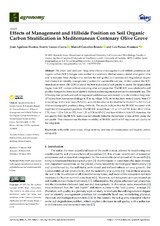Effects of Management and Hillside Position on Soil Organic Carbon Stratification in Mediterranean Centenary Olive Grove

View/
Author
Aguilera-Huertas, Jesús
Lozano García, Beatriz
González-Rosado, Manuel
Parras-Alcántara, Luis
Publisher
MDPIDate
2021Subject
Soil profileCover crops
Tillage systems
Land use
Chronosequence
Soil organic carbon
Soil quality
METS:
Mostrar el registro METSPREMIS:
Mostrar el registro PREMISMetadata
Show full item recordAbstract
The short- and medium—long-term effects of management and hillside position on soil organic carbon (SOC) changes were studied in a centenary Mediterranean rainfed olive grove. One way to measure these changes is to analyze the soil quality, as it assesses soil degradation degree and attempts to identify management practices for sustainable soil use. In this context, the SOC stratification index (SR-COS) is one of the best indicators of soil quality to assess the degradation degree from SOC content without analyzing other soil properties. The SR-SOC was calculated in soil profiles (horizon-by-horizon) to identify the best soil management practices for sustainable use. The following time periods and soil management combinations were tested: (i) in the medium‒long-term (17 years) from conventional tillage (CT) to no-tillage (NT), (ii) in the short-term (2 years) from CT to no-tillage with cover crops (NT-CC), and (iii) the effect in the short-term (from CT to NT-CC) of different topographic positions along a hillside. The results indicate that the SR-SOC increased with depth for all management practices. The SR-SOC ranged from 1.21 to 1.73 in CT0, from 1.48 to 3.01 in CT1, from 1.15 to 2.48 in CT2, from 1.22 to 2.39 in NT-CC and from 0.98 to 4.16 in NT; therefore, the soil quality from the SR-SOC index was not directly linked to the increase or loss of SOC along the soil profile. This demonstrates the time-variability of SR-SOC and that NT improves soil quality in the long-term.
